Summary: Low levels of stripe rust was detected in Colorado, along with moderate levels of bacterial and viral diseases.
Dr. Robyn Roberts
Field Crops Pathologist and CSU Assistant Professor Robyn.Roberts@colostate.edu*
970-491-8239
*Email is the best way to reach me
Disease Observations
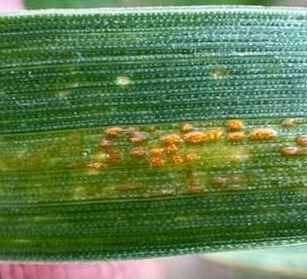
Stripe Rust
Stripe rust was found in Kit Carson and Yuma counties at very low levels (Figure 1). There is a fair amount being reported in Kansas, Nebraska, Oklahoma, and Texas as well, so the inoculum levels are moderate and there is a greater risk of disease development in the coming weeks. Stripe rust disease is dependent upon cool, wet weather, so stripe rust risk is greatest in the northeast counties that received recent rainfall and have had cooler weather. Stripe rust disease develops when temperatures are cooler (between 50-64°F) and generally wet from intermittent rain or dew. You may want to consider applying fungicides to manage stripe rust disease since the recent and predicted weather conditions are conducive to disease development in many areas of Colorado.
Bacterial leaf streak and bacterial blight diseases:
Bacterial leaf streak disease (BLS, caused by Xanthomonas translucens) and bacterial blight disease (BB, caused by Pantoea species) were detected in moderate levels in Baca and Washington counties (Figure 2). Symptoms appear as long yellow streaks, brown necrotic (dead) spots, and ‘water-soaked’ lesions which appear wet on a leaf. My group discovered and reported bacterial blight in wheat in Colorado
(and the United States) for the first time last year, suggesting this is an emerging pathogen of wheat. There could be many reasons for the emergence of the pathogen, but because it is new there are many unknowns. My group is continuing to investigate the disease and what the implications may be for Colorado. Bacterial leaf streak is a re-emerging pathogen in Colorado, and my research group has found that some of the recent isolates (‘strains’) from Colorado are much more aggressive than other isolates found across the United States.
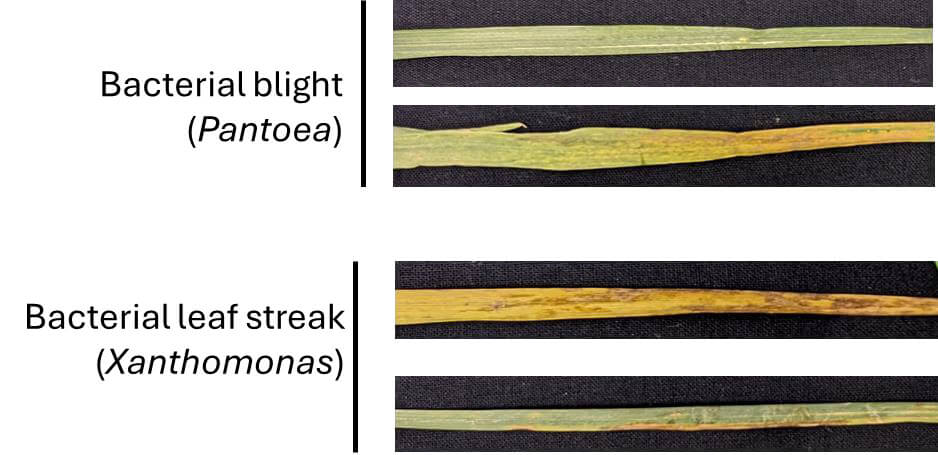
(bottom), caused by Xanthomonas. Symptoms appear similar between bacterial diseases but are caused by different pathogens.
Management and prevention: Unfortunately, there is no chemical or pesticide available to control BLS or BB and no disease resistance. The best management practices are to try to quarantine diseased areas as much as possible. This includes not moving equipment through these areas (or cleaning/disinfesting machinery thoroughly after use), and walking through these field areas last (it can probably spread on clothes). It is likely spread through rain and irrigation water, and may be seed transmitted. Be vigilant in scouting for BLS and BB, and if you observe it please contact me.
Triticum mosaic virus:
Plants testing positive for Triticum mosaic virus (TriMV) were collected from Baca, Kit Carson, Sedgwick, Logan, and Washington counties (Figure 3). TriMV is transmitted by the wheat curl mite, and symptoms appear as yellow streaks and mosaic patterns on leaves. In the past, TriMV was typically found when co-infected with Wheat streak mosaic virus (WSMV), but we have not yet detected any WSMV this year in Colorado (one sample from Nebraska tested positive for a TriMV+WSMV co-infection). We have observed an increasing number of TriMV-only positive samples over the past two years, so I encourage you all to stay vigilant in scouting and controlling volunteer wheat.

Management and prevention: There is no treatment for virus-infected plants, and no miticides are effective against the vector (the wheat curl mite). Controlling volunteer wheat and planting mite-resistant varieties are the best control measures. There is limited resistance available against TriMV, so controlling volunteer wheat between harvest and planting is critical.
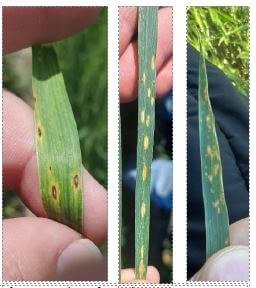
Tan Spot, Stagonospora leaf blotch, and Septoria leaf spot
Tan spot, Stagonospora leaf blotch, and Septoria leaf spot diseases were observed at very low levels in Washington, Baca, and Sedgewick counties (Figure 4). All three diseases are caused by different fungi and can appear this time of year. However, the diseases are dependent on wet conditions and the risk will vary by location. Wet, rainy weather, high humidity, and moderate temperatures (~68-75°F) favor disease development, and recent weather has been favorable for disease development in some areas. The pathogens survive in infected residue. Typically, fungal leaf diseases do not cause significant yield losses in Colorado.
Management and prevention: As long as the weather continues to get warmer, fungal leaf spot disease activity should decrease. Because the pathogens survive in wheat residue, rotating crops will help reduce the number of spores in a field the following years. Fungicide seed treatments also help protect seedlings from infection.
Disease Watch and Management
Fusarium Root Rot and Crown Rot
Planting Fusarium-infected seed from 2023 can lead to root rot disease this year (Figure 5). Seeds infected with FHB may or may not show symptoms or signs of FHB but can still be infected. If infested seed is planted, root rot and crown rot may develop, as the fungus emerges and infects wheat plants directly from the seed. Prolonged drought stress coupled with high soil temperature in the fall promotes early disease development, so conditions last fall were favorable for disease. I encourage you to read more about Fusarium diseases in a recent University of Nebraska extension group article, which can be found here: https://tinyurl.com/bdhvpjt9.
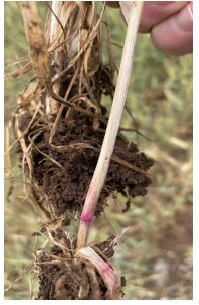
Fusarium head blight (head scab)
The 2023 Field Season ended with significant Fusarium head blight (head scab, FHB, Figure 6). The fungal pathogen requires wet conditions, so FHB is more common after significant, prolonged rainfall, much like what we encountered in late May-early June last year. It prefers warm temperatures (~75-85°F), but under extended wet conditions the fungus can infect at cooler temperatures. The fungus infects flowers, so the timing of the wet, warm weather with flowering last year provided optimal conditions for disease development.
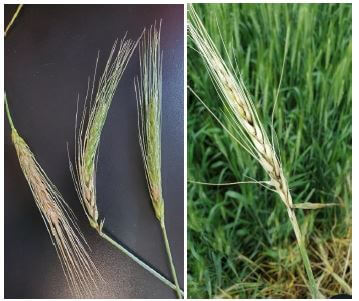
Penn State University and colleagues at the Fusarium Scab Initiative have developed a risk assessment tool to predict the likelihood of FHB. I will be monitoring the site throughout the year, but you may also conduct your own risk assessment using their tool, available at: https://tinyurl.com/2jcvcze9. Colorado is currently in a low-risk category for disease development.
Additional Resources
- Colorado Wheat Entomology Newsletter: https://coloradowheat.org/category/news-events/wheat-pest-and-disease-update/
- Fusarium risk tool:
https://www.wheatscab.psu.edu/?ct=YTo1OntzOjY6InNvdXJjZSI7YToyOntpOjA7czo1OiJlbWFpbCI7aToxO2k6NjM7fXM6NT oiZW1haWwiO2k6NjM7czo0OiJzdGF0IjtzOjIyOiI2NjA1OWYxMzk5MmJjMzY4ODcyMDIyIjtzOjQ6ImxlYWQiO3M6MjoiMjAiO 3M6NzoiY2hhbm5lbCI7YToxOntzOjU6ImVtYWlsIjtpOjYzO319 - Fusarium article, Uncommon Wheat Disease in the Nebraska Panhandle in 2023:
https://cropwatch.unl.edu/2024/uncommon-wheat-disease-nebraska-panhandle-
2023?utm_source=University+of+Nebraska-Lincoln+CropWatch&utm_campaign=41a18a2c0f-
EMAIL_CAMPAIGN_2020_08_14_COPY_01&utm_medium=email&utm_term=0_d184080585-41a18a2c0f-137130681 - Information about the ‘green bridge’ and risks for viral diseases due to volunteer wheat:
https://eupdate.agronomy.ksu.edu/article_new/spring-emerged-volunteer-wheat-should-producers-worry-about-wheat-streak-mosaic-virus-and-the-green-bridge-436-4 - Fungicide Efficacy for Control of Wheat Diseases Table: https://cropprotectionnetwork.org/publications/fungicide-efficacy-for-control-of-wheat-diseases
CONTRIBUTORS: Many thanks to Sally Jones-Diamond, Tyler Benninghoven, Ron Meyer, and Dr. Esten Mason who contributed to this report.